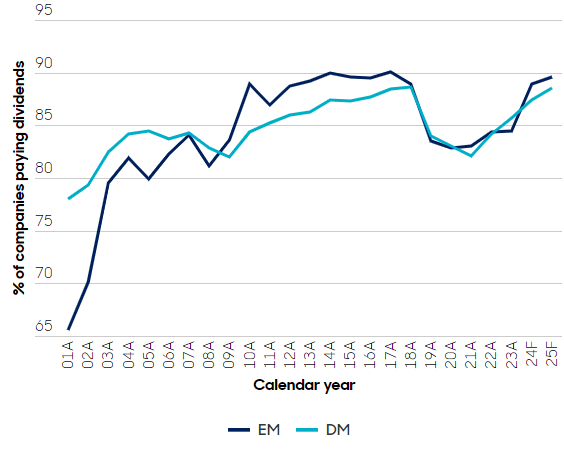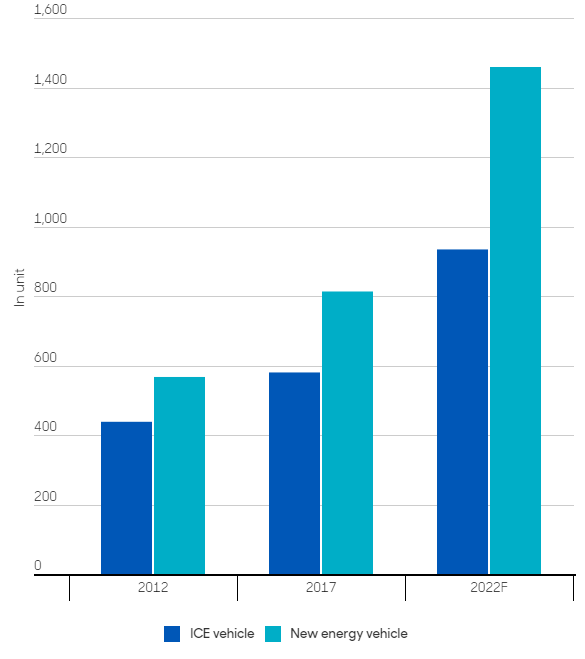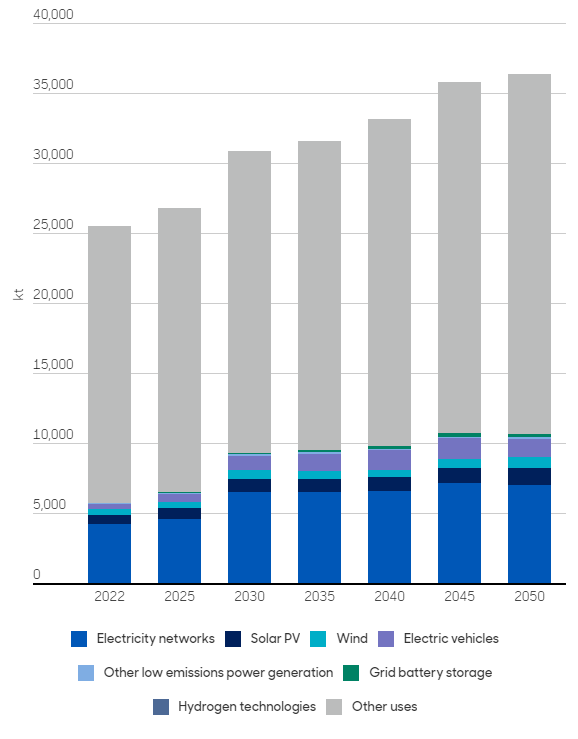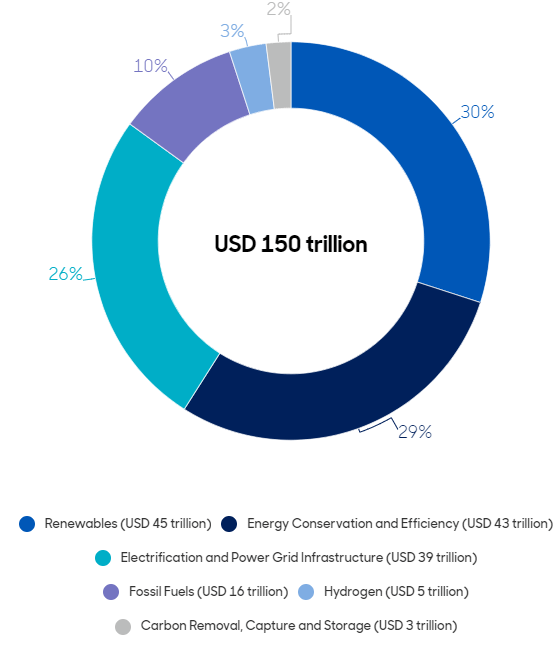Which emerging market companies are capable of paying dividends over the long term?
AUTHOR Matt Williams Senior Investment Director
Not every dividend payer is created equal.
The challenge for income investors is finding a company that offers an attractive payout for its shareholders and can do so over the long term.
Emerging market equities are increasingly exhibiting these characteristics. We explore key developments that can help identify future opportunities.
Many dividend payers to choose from, but which are in it for the long haul?
Evidence is mounting that emerging markets (EM) are a fertile hunting ground for income and capital growth. The proportion of EM companies paying a dividend has grown significantly over the last two decades (Chart 1), with around 90% now doing so (and more than one-third of these yielding over 3%).1,2
Chart 1. MSCI universe – Companies paying dividends
Source: FactSet, Jefferies Equity Research, July 2024
Making these judgments requires detailed fundamental analysis, but we also look at external influences. However well-run it is, a business needs to be in the right place at the right time to prosper.
We identify three essential cross-sector and cross-region microeconomic developments that allow us to pinpoint the companies that are most capable of generating long-term shareholder income:
1. Technology as a platform
Technology has helped transform EM from a group of economies dominated by commodities to something much more diversified.
Many EM companies have embraced leapfrog innovation, adopting more advanced technologies, such as digital payments, to bypass the more conventional routes to growth. This has allowed them to catch up – or surpass – developed market competitors.
We’ve entered a new digital era powered by artificial intelligence (AI), affecting everything from travel to spending money. What makes the growth of the digital era such a powerful investment trend is that many vital technologies are coming together at the same time. Like a railway network, which requires significant investment in its tracks to get trains from A to B, this new digital economy requires technology and hardware to meet its demands.
For example, generative AI models such as ChatGPT or a Chinese technology giant's AI chatbot service product are expected to contribute US$4.4 trillion to the global economy.3 However, this transformational innovation requires vast amounts of processing power. Indeed, the supercomputer behind ChatGPT contains more than 285,000 processor cores and 10,000 graphics cards.4
Smarter transport technology also demands additional sensors and components (Chart 2).
Chart 2. # of sensor chips required for different levels of autonomous driving
Source: Deloitte analysis, November 2021
Electric vehicles need more sophisticated chips and in greater numbers than the more conventional internal combustion engine cars (Chart 3).5
Chart 3. # of chips per vehicle in China, 2012–2022
Source: Deloitte analysis, November 2021
Autonomous vehicles require even more. Essential functions such as judging road positioning and making split-second safety decisions need large technology sets, including GPS, radar, and LIDAR.
Technology hardware forms the building blocks for the new digital economy. Much of it’s sourced from EM. The world’s largest semiconductor foundry is a Taiwanese multi-national semiconductor contract manufacturing and design company. It provides high-performance chips to major global brands. Emerging Asia is also home to global players, including several memory chip manufacturers and semiconductor giants.
2. Energy transition
The agreement signed at COP28, the UN climate change summit, was billed as “the beginning of the end” for the fossil fuel era.6 While nations, companies, and activists disagree over the pace of change needed to cut harmful CO2 emissions, the trend points towards greener, lower-carbon energy sources. Other factors – not least Russia’s invasion of Ukraine – have forced policymakers to rethink their dependence on a handful of exporters for their energy needs.
There is already a well-established scale and development of renewables in EM. These markets are also the focal point as the energy transition accelerates. Developments include expanding national power grids in India, exploring new technologies like carbon capture and storage, or adopting new fuel sources such as hydrogen. A prime example is electric battery technology, which is essential for many aspects of the energy transition. Global demand for lithium-ion batteries is expected to grow by about 27% annually, reaching around 4,700 GWh by 2030.7
Many essential materials required for greener technology, such as copper and platinum, are mined in EM countries, particularly Latin America. Demand for copper in solar PV (photovoltaics), wind, grid-battery storage, and more is forecast to rise from around 25,000 kilotons in 2022 to nearly 40,000 kt by 2050 (Chart 4).8 Rising demand for these minerals will prove beneficial to mining companies.
Chart 4. Total demand for copper in the IEA’s Announced Pledges Scenario9
Source: IEA, Licence: CC BY 4.0, 2023
So far, investment levels significantly lag what is needed to meet ambitious net-zero emission targets. According to the most recent estimates, the cumulative investment gap to keep the global temperature rise below 1.5°C by 2050 (above pre-industrial levels) is US$150 trillion (Chart 5).10 With this in mind, we expect continued acceleration in projects over the next few years, giving EM companies a platform to flourish.
Chart 5. Cumulative investment needs under 1.5°C scenario, 2023–2050
Source: International Renewable Energy Agency, World Energy Transitions Outlook 2023
3. A new generation of consumers
Spending power is rising dramatically in EM. Nations, including India and Indonesia, have significantly increased working-age populations. Together with fewer people having to support dependents, this is a recipe for potentially greater economic growth.
While the definition of middle class can vary, median income has increased substantially across many EM countries in recent years.11 By one count, in 2024, 113 million people will enter the global consumer class, with 57% living in China and India.12
This backdrop of consumption growth is favorable for dividend-paying companies. It stretches across several industries, including food and beverages, sportswear, electrical appliances, automotive vehicles, airports, and financial products like insurance or banking.
For us, one of the most important aspects is that consumers are expressing a preference for domestic brands over global names. This benefits some leading EM companies that have already established significant market share in their respective industries.
In China, for example, despite long-standing demand for premium imported spirits like whisky, there’s still a strong market for baijiu, a Chinese liquor made from fermenting cooked sorghum. This has boosted some of the country’s leading drinks manufacturers. Meanwhile, the world's largest home appliance company, has grown its domestic range of own-brand products to dominate the markets for washing machines, air-conditioning units, and kitchen appliances.
Final thoughts
Taken together, these three microeconomic themes, which frequently overlap, help set the backdrop for well-run companies with established and loyal customer bases to sustain and grow their businesses. Alongside our follow-the-cash-flow analysis – focusing on companies with strong balance sheets and attractive fundamentals – these themes help us stay alert to opportunities in cash-generative companies capable of paying out sustainable and growing dividends to shareholders.
We look for companies that effectively use capital to generate a profitable income stream. This means they can invest internal funds to secure a competitive advantage over their peers while leaving enough cash to provide attractive distributions to shareholders. We also often look for companies where we see potential for income in the future. Our balanced two-pillar approach (whereby we invest 50% in high dividends and 50% in dividend growth) aims to capture the vast income and growth opportunity in EM.
The combination of high levels of income and sufficient capital reinvestment should result in attractive, growing dividend yields for shareholders as these businesses continue to expand.
1 Factset, Jefferies Equities Research, January 2024.
2 Bloomberg, October 2023.
3 "AI could increase corporate profits by $4.4 trillion a year, according to new research." McKinsey, July 2023. https://www.mckinsey.com/mgi/overview/in-the-news/ai-could-increase-corporate-profits-by-4-trillion-a-year-according-to-new-research.
4 "Microsoft announces new supercomputer, lays out vision for future AI work." Microsoft, May 2020. https://news.microsoft.com/source/features/ai/openai-azure-supercomputer/.
5 Deloitte analysis in Global Corporate Venturing EVs drive future demand for car semiconductors, 2023.
6 "COP28 agreement marks the beginning of the end of fossil fuels." Earth.com, December 2023. https://www.earth.com/news/cop28-agreement-marks-the-beginning-of-the-end-of-fossil-fuels/.
7 "Battery 2030: Resilient, sustainable, and circular." McKinsey, January 2023. https://www.mckinsey.com/industries/automotive-and-assembly/our-insights/battery-2030-resilient-sustainable-and-circular.
8 Critical Minerals Data Explorer. International Energy Agency, May 2024. https://www.iea.org/data-and-statistics/data-tools/critical-minerals-data-explorer.
9 Announced Pledges Scenario (APS). Global Energy and Climate Model. International Energy Agency, October 2023. https://iea.blob.core.windows.net/assets/ff3a195d-762d-4284-8bb5-bd062d260cc5/GlobalEnergyandClimateModelDocumentation2023.pdf.
10 World Energy Transitions. Outlook 2023: 1.5°C Pathway. International Renewable Energy Agency, June 2023. https://www.irena.org/Publications/2023/Jun/World-Energy-Transitions-Outlook-2023.
11 Haver, March 2021.
12 "113 Million People Will Join the Global Middle Class in 2024." Visual Capitalist, October 2023. https://www.visualcapitalist.com/113-million-people-middle-class-2024/.
Important information
FOR PROFESSIONAL INVESTORS ONLY. NOT FOR USE BY RETAIL INVESTORS.
Projections are offered as opinion and are not reflective of potential performance. Projections are not guaranteed and actual events or results may differ materially.
Fixed income securities are subject to certain risks including, but not limited to: interest rate (changes in interest rates may cause a decline in the market value of an investment), credit (changes in the financial condition of the issuer, borrower, counterparty, or underlying collateral), prepayment (debt issuers may repay or refinance their loans or obligations earlier than anticipated), call (some bonds allow the issuer to call a bond for redemption before it matures), and extension (principal repayments may not occur as quickly as anticipated, causing the expected maturity of a security to increase).
Foreign securities are more volatile, harder to price and less liquid than U.S. securities. They are subject to different accounting and regulatory standards, and political and economic risks. These risks are enhanced in emerging markets countries.
All material presented is compiled from sources believed to be reliable and current, but accuracy cannot be guaranteed. This is not to be construed as an offer to buy or sell any financial instruments. It is not our intention to state, indicate or imply in any manner that current or past results are indicative of future profitability or expectations. As with all investments there are associated inherent risks. Please obtain and review all financial material carefully before investing.
abrdn offers a variety of products and services intended solely for investors from certain countries or regions. abrdn does not offer these products or services outside their intended countries or regions. Your country of legal residence will determine the products or services that will be available to you. Nothing on this website should be considered a solicitation or offering for sale of any investment product or service to any person in any jurisdiction where such solicitation or offer would be unlawful. Persons residing outside the United States are invited to visit our global website for more information about products and services available to non-U.S. investors.
UNITED STATES RESIDENTS
The purpose of this website is to provide general information about the US-registered investment advisers which are part of abrdn, and the strategies they manage. The information provided is not intended as an offer or solicitation for the purchase or sale of any financial instrument.
Past performance is not indicative of future results, and there can be no guarantee as to the accuracy of market forecasts. Opinions, estimates, and forecasts may be changed without notice. This site does not provide financial or investment advice and does not take into account the particular financial circumstances of individual investors. Before investing, investors should seek their own professional advice. The views and opinions expressed are provided for general information only, and do not constitute specific tax, legal, or investment advice to, or recommendations for, any person. We suggest that you consult your financial or tax advisor, accountant, or attorney with regard to your specific situation.
In the United States, abrdn is the marketing name for the following affiliated, registered investment advisers: abrdn Inc., abrdn Investments Limited, and abrdn Asia Limited
AA-040924-182694-1







